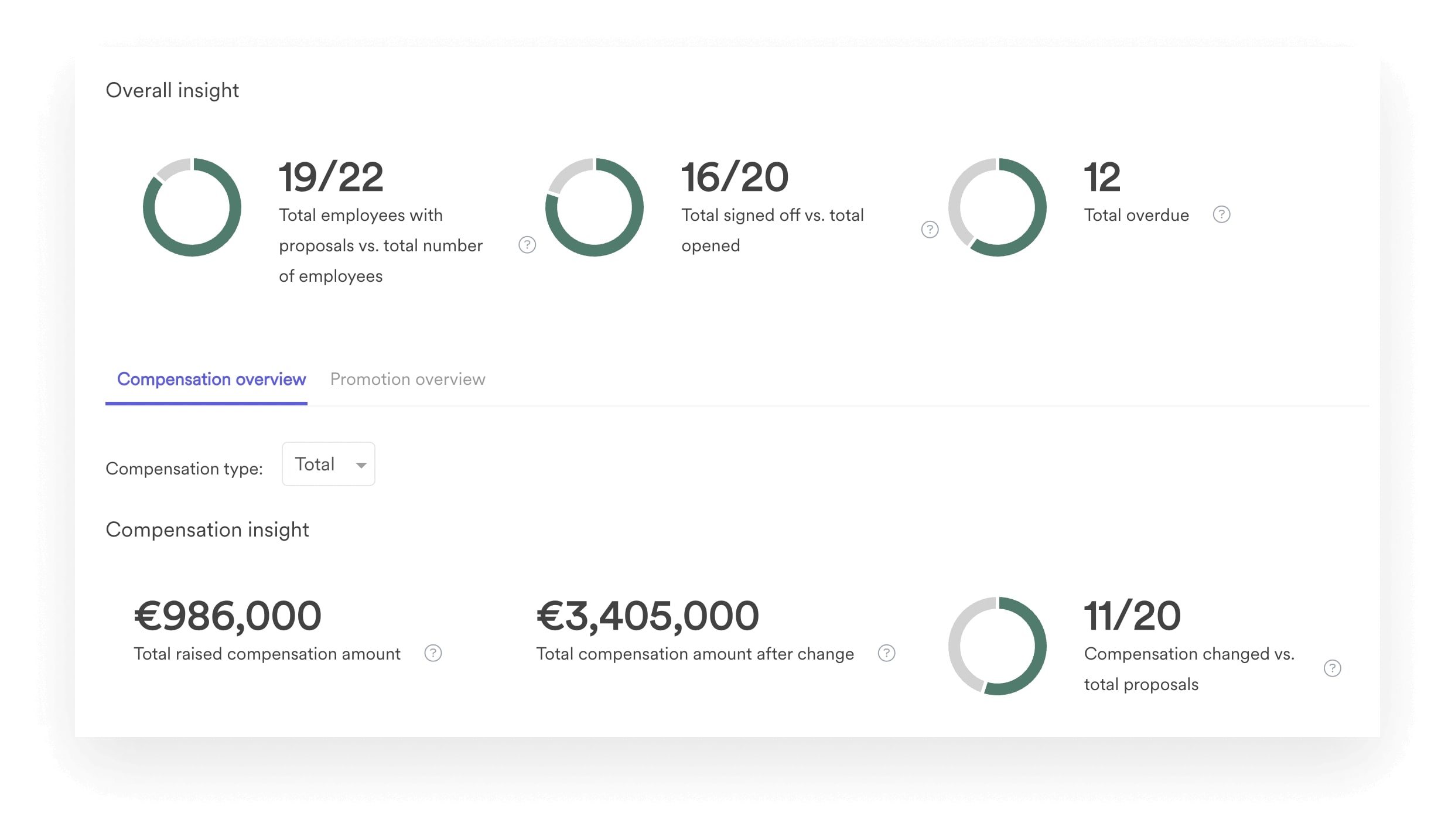What is a performance bonus & how to implement it at your company
.png)
The broad array of performance bonuses — both monetary and non-monetary — implemented by companies today enable employers to be innovative and strategic with how they reward and motivate employees. What’s more, they’re becoming more important than ever.
Why? Recent data shows that pay raises are likely to trend downward from an average of 4.4% to 4%, likely due to increasing economic turbulence and diminishing job opportunities for employees.*
As a result, more companies will need to offer competitive performance bonus packages to keep their top talent happy while staying within their organizational budgets.
In a fluctuating business landscape, the performance-based bonus presents a win-win solution for both employers and employees, as long as organizations are willing to collaborate with team members to get it right.
The good news is that it’s possible to create performance bonus plans that satisfy everyone — which is why, in this article, we’ll discuss:
- What performance bonuses are and how they work
- The difference between monetary and non-monetary bonuses
- A step-by-step guide to implementing an effective performance bonus plan
*Willis Towers Watson, 2023
🚀 Leapsome is your next step in compensation planning
Now integrating powerful Mercer data, Leapsome Compensation gives you access to external benchmarks, internal analytics, and planning tools to simplify compensation management.
👉 Learn more
What is a performance bonus?

A performance bonus is a form of supplemental compensation that companies use to reward employees when they meet performance goals or agreed-upon objectives. It’s typically awarded around the time of a performance review, although an organization may choose to distribute it whenever they want to incentivize employees.
A performance-based bonus can come in monetary and non-monetary forms. Some of the most common performance bonuses include:
- Spot bonuses — Usually awarded upon completion of a specific task or meeting a goal, and they’re often unexpected
- Profit-sharing bonuses — A bonus based on company performance in which employees receive a percentage of company profits for a given period
- Annual performance bonuses — Reward employees for their contributions and development over a year
- Task bonuses or mission bonuses — Usually given after the conclusion of a large project or after hitting a significant milestone, such as the completion of a certain number of initiatives or serving a certain number of clients
Monetary vs. non-monetary: performance bonus examples

Non-monetary bonuses can be used to reward employees who embody company values
Both monetary and non-monetary performance-based bonuses exist to celebrate employee successes at work and show that you appreciate them. Still, deciding whether to reward employees with monetary vs. non-monetary performance bonuses depends on your desired results.
For example, if your goal is to get employees to meet sales targets or increase annual revenue by a certain percentage, a monetary bonus based on performance is a great way to show that when employees achieve revenue-generating benefits for the company, they’ll receive financial rewards.
Non-monetary bonuses tend to be more effective when rewarding employees for less financially tangible contributions — like how they embody company values or have made strides to advance within their development frameworks. These bonuses also tend to be more cost-effective.
Types of non-monetary bonuses include:
- Development opportunities like leadership training or courses to help an employee upskill
- Extra days off
- Fringe benefits like lunches, tickets to local events, or access to health and fitness programs
- Time off for volunteering with their favorite local charities or projects
- Free experiences like trips or unique activities in your area
How to implement a performance bonus plan
If you want your performance-based bonuses to effectively motivate, reward, and even engage your people, here’s our quick guide to setting up a performance bonus plan for your organization.
💡 Not sure how to assess employee performance to implement so you can create the right bonus plan?
Leapsome’s performance reviews and skills frameworks can give you the actionable data and insights you need while creating and implementing performance bonus plans and setting up monetary rewards for your organization.
1. Choose your criteria & objectives
“The point is trying to drive outcomes. HR needs to work really closely with the business to determine: ‘What are we willing to pay for to get the outcomes we’re looking for?’”
— LaCinda Glover, Senior Principal Consultant at Mercer, in a piece for WorldAtWork
The first thing to decide is whether your performance-based bonus structure will be geared toward an individual employee, a team, or employees across the company. Once you’ve decided who the plan is for, you can set the objectives for the performance bonuses — what results you want — and the performance criteria — what individuals or teams must do to earn the bonuses.
Suppose your goal is to motivate your team leaders to increase team engagement by a certain percentage. In that case, you might award the next performance bonus based on whether employees report feeling more supported and their efforts valued by their team lead in engagement surveys.
However, if you want to motivate more cross-functional hiring at the company level in the next three months, you could implement a referral bonus program for that quarter.
2. Invite employees to participate in setting objectives

An effective performance bonus plan starts with choosing the right objectives
At this stage, you still have the opportunity to refine your objectives, and ideally, you’ll invite your staff into this process. Why? Employees likely have more insight into how achievable your objectives are at any given point. In addition, setting objectives with them — rather than simply delegating these objectives to them — helps guarantee that individual goals are compatible with company goals.
Gathering team member input also helps you build a more competitive performance bonus plan. “If talent can find better pay and benefits elsewhere, most won’t hesitate to leave,” says Payscale’s Chief People Officer, Lexi Clarke, for WorldAtWork. “Even listening to employee feedback is an effective way to see what your employees’ bonus expectations are.”
3. Research performance-based bonuses for your employee needs & industry
Performance bonuses work best when the type of bonus matches your goals — and that means thinking outside of the annual holiday bonus box and researching what performance-based bonus works best for your industry.
On the individual level, for instance, you might award your company leadership an annual performance bonus if they meet targets in time for their leadership performance review. Similarly, at the company level, maybe your goal is to increase your revenue. In this case, profit-sharing bonuses let your employees enjoy the monetary benefits of their laser-focused efforts.
For tech teams and companies that use the SCRUM project management framework and work on tight deadlines, a mission bonus — typically awarded after completing a large milestone project — might be a great way to honor your teams’ hard work.
4. Select the performance bonus type that best suits your needs
We’ve mentioned different kinds of performance bonuses, but let’s consider them further with a few performance-based rewards examples. That way, you can reflect on the types that might work best for you.
- Spot bonuses — Awarded “on the spot” when employees achieve a specific result or complete a task.
- Task or mission bonuses — Similar to spot bonuses, but they’re usually larger, lump-sum bonuses to reward employees who reached a milestone.
- Profit-sharing bonuses — These can be given out regularly or on particular occasions to motivate employees to help meet revenue goals.
- Annual performance bonuses — Often distributed around the same time as the performance review. While some companies worry that they shouldn’t tie compensation to performance reviews, this assures employees that bonuses and raises aren’t arbitrary.
- Holiday bonuses — Companies often offer yearly bonuses to show appreciation for their people or celebrate successes.
- Sign-on bonuses — These are used to attract new talent and are offered to new hires during the onboarding process.
- Referral bonuses — Rather than relying solely on recruiters, companies use referral bonuses to incentivize their employees to help staff open positions.
5. Follow up on results & measure ROI
Once you’ve delivered your employee bonuses, you need to track the results of your performance bonus plan on employee productivity and engagement.
Leapsome can help you throughout this process as an all-in-one people enablement solution that lets you track employee performance, measure employee engagement, and manage compensation — all on the same platform. Our engagement, compensation, and performance tools communicate so you can use performance review and employee engagement insights to inform your performance bonus planning for the future.
Motivate & reward your employees with Leapsome

The performance bonus isn’t just about issuing incentives. You should be strategic and creative with your bonuses to motivate and reward your people — and you need a system in place to help you track the success of your performance bonus plan.
As a holistic people enablement platform, Leapsome can help you measure the impact of your bonuses on employee engagement and determine what drives employee performance and what doesn’t. Our Compensation module allows you to automate salary reviews, analyze company-wide pay data, compare it against Mercer-powered benchmarks, and update them to be more competitive. It also integrates with Leapsome Surveys, making obtaining employee feedback on your compensation packages easier.
Unlock the power of Leapsome to leverage pay more effectively, enhance employee engagement, optimize performance, and stay competitive in the face of a challenging economic outlook.
💪 Make your compensation plan work harder for you
Take advantage of Leapsome for comprehensive compensation management planning and scaling — including setting up performance-based bonuses.
👉 Book a demo
Sind Sie bereit, Ihre Strategie zur Mitarbeiterförderung zu verbessern?
Informieren Sie sich über unsere Leistungsbeurteilungen, Ziele und OKRs, Engagement-Umfragen, Onboarding und mehr.
.webp)
.webp)
 Fordern Sie noch heute eine Demo an
Fordern Sie noch heute eine Demo an






.png)

















